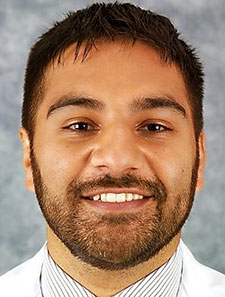 Realizing that patients cared for at rural and critical-access hospitals struggle with access to interventional endoscopy procedures at tertiary care centers, a Minnesota hospital began a bold project in 2021: The hospitalist team began offering round-trip procedures in which patients would be transported to St. Cloud Hospital, have the procedure performed, and be transported back to their local hospital, in some cases 100 miles away, that same day.
Realizing that patients cared for at rural and critical-access hospitals struggle with access to interventional endoscopy procedures at tertiary care centers, a Minnesota hospital began a bold project in 2021: The hospitalist team began offering round-trip procedures in which patients would be transported to St. Cloud Hospital, have the procedure performed, and be transported back to their local hospital, in some cases 100 miles away, that same day.
The project has been a success, but thanks to a new feature in the Journal of Hospital Medicine (JHM), the effort hasn’t stopped there: It is the topic of one of the reports in the journal’s Innovations Corner, its newest article type.1 The articles include an easy-to-follow visual depiction of the project that allows ideas to be quickly conveyed to administrators, should they consider rolling out such a program of their own.
Innovations Corner joins the Point-Counterpoint article series in which an important hospitalist topic is assessed from two opposing perspectives rather than as a standard article. Such features present well-documented and well-researched topics in digestible and untraditional ways in order to best serve readers, JHM editors say.

Dr. Sata
“Innovations Corner encourages a more engaging experience for our readers, making it easy for them to stay informed and inspired in our rapidly evolving field,” said JHM editor-in-chief, Samir Shah, MD, professor of pediatrics at the University of Cincinnati. “The point-counterpoint format introduces readers to contrasting perspectives, sparking critical thinking by presenting well-supported arguments from different viewpoints—a dynamic that traditional reviews and commentaries lack.”
Submissions for the Innovations Corner and Point-Counterpoint can be sent through JHM’s website, which has a “no hassle” process designed to be simple and streamlined, allowing free-format submissions and then later guidance on manuscript formatting, if needed.
Suchita Shah Sata, MD, SFHM, deputy editor at JHM who oversees the Innovations Corner series and is an associate professor of medicine at Duke University in Durham, N.C., said the articles are a way for hospitalists leading improvement initiatives to showcase their work in an increasingly competitive publishing environment.
“There is a great market for multi-center research collaborations and large-scale quality improvement research, and the publishing bar for many of the existing journals that publish QI [quality improvement] work has gotten pretty high—it’s rare for single-center, hospital-based innovations to meet that publication mark compared to other existing larger scale projects,” Dr. Sata said. “At the same time, hospitalists around the country are doing essential work locally, innovating to improve care for their patients at their own institutions and own health systems.”
It’s a way for other hospitalists and centers to learn of problem-solving they might be able to implement themselves, she said.
“Other hospitals and systems across the country are experiencing similar problems and can learn from the successes and challenges that other teams have experienced.”
In the same-day round-trip interventional endoscopy project in Minnesota, hospitalists reported that 84 patients benefited from the service over 20 months, with very few needing admission to St. Cloud Hospital after their procedures and none needing transfer back to St. Cloud once the trip was complete.1 But researchers said that communication with the anesthesiology team, ambulance service, and support from advanced practice providers and nurses was crucial to success.
The piece, as Innovations Corner articles do, includes not only a visual abstract but also a QR code that can be used to connect readers quickly to the study author by email if they have more questions.
“It helps other places to say, ‘We can do this, we should do this, I know people who have done it, let’s scan the QR code and email the author,’” Dr. Sata said. “‘This is not impossible even if it sounds like a really big lift and it’s good for our patients.’ And as hospitalists, we are the ones leading that innovation and bringing our innovation care forward.”
Another piece reported on a project at Johns Hopkins that found the best way to offer feedback to residents to cut down on wasteful lab testing, was through individual communication in the middle of the academic year, rather than in groups or at the beginning or toward the end of the year.2
“Every hospital has struggled with the idea of excessive lab testing and we know it’s a problem—the question is how do you fix it?” Dr. Sata said. “And they actually fixed it and studied it and found a way to time that feedback.”
She said she looks for projects that are relevant and generalizable.
“What really excites me when I see papers submitted to us are the ones that immediately strike us as, wow, that’s a problem that so many other places probably are dealing with and this is a really unique solution or a unique process that’s implemented to try to solve this problem,” she said. “It could be replicable on a broader scale and not just something that relies on the immediate local culture.”
Dr. Sata said she was drawn to the feature, which she has overseen since its inception in April 2024, in part because she had spent the prior year as a digital media editorial fellow at the journal, and the idea of a series that incorporates a visual abstract design was appealing.
She said she also liked the idea of encouraging innovating hospitalists to publish their work.
It can be, she said, “daunting to think about publishing this work, and the intimidation of it prevents a lot of people, including me, from even trying. And so that was another avenue. We want to find a home that is friendly to authors and also high-quality, peer-reviewed science.”
The Point-Counterpoint series takes a similar outside-the-box approach to presenting hospitalists with valuable data and discussion.

Dr. Kanjee
Zahir Kanjee, MD, MPH, a deputy editor at JHM, hospitalist at Beth Israel Deaconess Medical Center, and assistant professor of medicine at Harvard Medical School, both in Boston, said he was drawn to the idea of a topic discussed from different angles and has been overseeing Point-Counterpoint since April 2022, just after it was launched.
“I was interested in the idea of really engaging with the topic from both sides and working with a group of authors who had different perspectives on a topic that was relevant to all of us,” he said. “It was fun to get to learn both perspectives and it was a neat opportunity to dive into something that we don’t always think about or don’t always examine.”
The aim of the series, he said, is to approach and debate a topic “in a scholarly and evidence-based manner in a way that is easy to read and fun to read and engaging.”
In a Point-Counterpoint on whether to continue to use the SOAP—subjective, objective, assessment and plan—method for chart notes, one side argued that SOAP has outlived its usefulness, contributed to note bloat and even inhibited clinical thinking, while the other argued it still serves many purposes, including helping with patient safety, communication, and assisting clinical reasoning.3
Despite the detailed arguments, the piece has a fairly breezy feel and even touches of humor.
Dr. Kanjee said he leaves the authors free to write how they want, and this can lead to more engaging pieces.
“I think people’s passion for the topics tends to drive the tone,” he said. “People will approach me often with ideas of things that they’re passionate about and want to write about and want to discuss and want to dive into, and I think that that passion and excitement translates into an engaging article.”
The styles of the articles can vary, he said.
“Some writers want to do things a little bit more formally, some writers feel a little bit more comfortable being more whimsical, and I think either of those is fine as long as the topic is interesting, relevant, and the articles engaging to the readers,” he said.
He said he looks to publish articles with diversity in thought, demographics, practice settings, and geography. Sometimes, there is a separate team of writers for the point and the counterpoint. But sometimes, the same authors take on both sides, “which some folks feel gives them a little bit more freedom to comment on things and write about things,” he said.
“What I definitely have seen and experienced myself is people thinking about things in a new way” and “really seeing the other side’s perspective,” he said.
Some of the Point-Counterpoints have led to robust discussions in JHM Chats on the X social media platform.
“It’s been really nice,” Dr. Kanjee said, “to see a community engage around these topics and really discuss and think more critically about our field and about the care that we provide.”
Tom Collins is a medical writer in South Florida.
References
- Suresh MR, et al. Implementation of a same-day, round-trip interventional endoscopy service for rural and critical access hospital patients. J Hosp Med. 2024;19:971-6.
- Pahwa A, et al. OslerCare: Modifying timing and delivery of feedback to impact resident lab ordering practices. J Hosp Med. 2024;19:755-60.
- Rodman A, et al. Point-counterpoint: Time to wash away the SOAP note—or merely rinse it? J Hosp Med. 2023;18:957-61.